Querying Databricks Data as a Graph
Summary
In this tutorial, you will:
- Create tables in Databricks using Delta Lake format under Unity Catalog and load it with example data;
- Start a PuppyGraph Docker container and query the example data as a graph.
Prerequisites
- Please ensure you have a Databricks account with a workspace, catalog and SQL Warehouse set. This demo utilizes Databricks on AWS, but the setup is comparable for other platforms.
- Accessing the PuppyGraph Web UI requires a browser.
Deployment

docker run -p 8081:8081 -p 8182:8182 -p 7687:7687 -e PUPPYGRAPH_PASSWORD=puppygraph123 -d --name puppy --rm --pull=always puppygraph/puppygraph:stable
Data Preparation
This tutorial is designed to be comprehensive and standalone, so it includes steps to populate data in Databricks. In practical scenarios, PuppyGraph can query data directly from existing tables in your Databricks.

SQL Editor page, select your catalog and then execute the following SQL statements in the Editor to create Delta tables with data:
create table modern.person (id string, name string, age int) USING DELTA;
insert into modern.person values
('v1', 'marko', 29),
('v2', 'vadas', 27),
('v4', 'josh', 32),
('v6', 'peter', 35);
create table modern.software (id string, name string, lang string) USING DELTA;
insert into modern.software values
('v3', 'lop', 'java'),
('v5', 'ripple', 'java');
create table modern.created (id string, from_id string, to_id string, weight double) USING DELTA;
insert into modern.created values
('e9', 'v1', 'v3', 0.4),
('e10', 'v4', 'v5', 1.0),
('e11', 'v4', 'v3', 0.4),
('e12', 'v6', 'v3', 0.2);
create table modern.knows (id string, from_id string, to_id string, weight double) USING DELTA;
insert into modern.knows values
('e7', 'v1', 'v2', 0.5),
('e8', 'v1', 'v4', 1.0);
The above SQL creates the following Delta tables under the modern schema:
| id | name | age |
|---|---|---|
| v1 | marko | 29 |
| v2 | vadas | 27 |
| v4 | josh | 32 |
| v6 | peter | 35 |
| id | name | lang |
|---|---|---|
| v3 | lop | java |
| v5 | ripple | java |
| id | from_id | to_id | weight |
|---|---|---|---|
| e7 | v1 | v2 | 0.5 |
| e8 | v1 | v4 | 1.0 |
| id | from_id | to_id | weight |
|---|---|---|---|
| e9 | v1 | v3 | 0.4 |
| e10 | v4 | v5 | 1.0 |
| e11 | v4 | v3 | 0.4 |
| e12 | v6 | v3 | 0.2 |
Data Access Preparation

SQL Warehouses and select Connection details tab. Save the Server hostname as it would be used later.
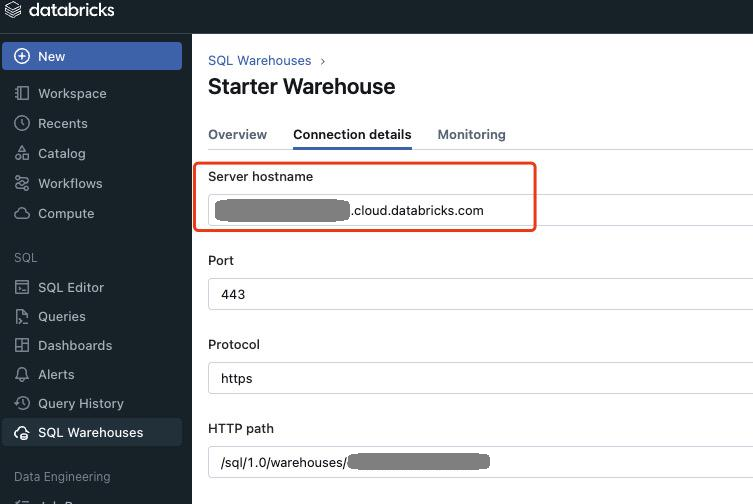

Settings as follows


Developer tab and then click on Manage button in the Access tokens section.


Generate new token and save the generated Databricks Access token for later use.


Modeling a Graph
We then define a graph on top of the data tables we just created. Actually, this is the "Modern" graph defined by Apache Tinkerpop.
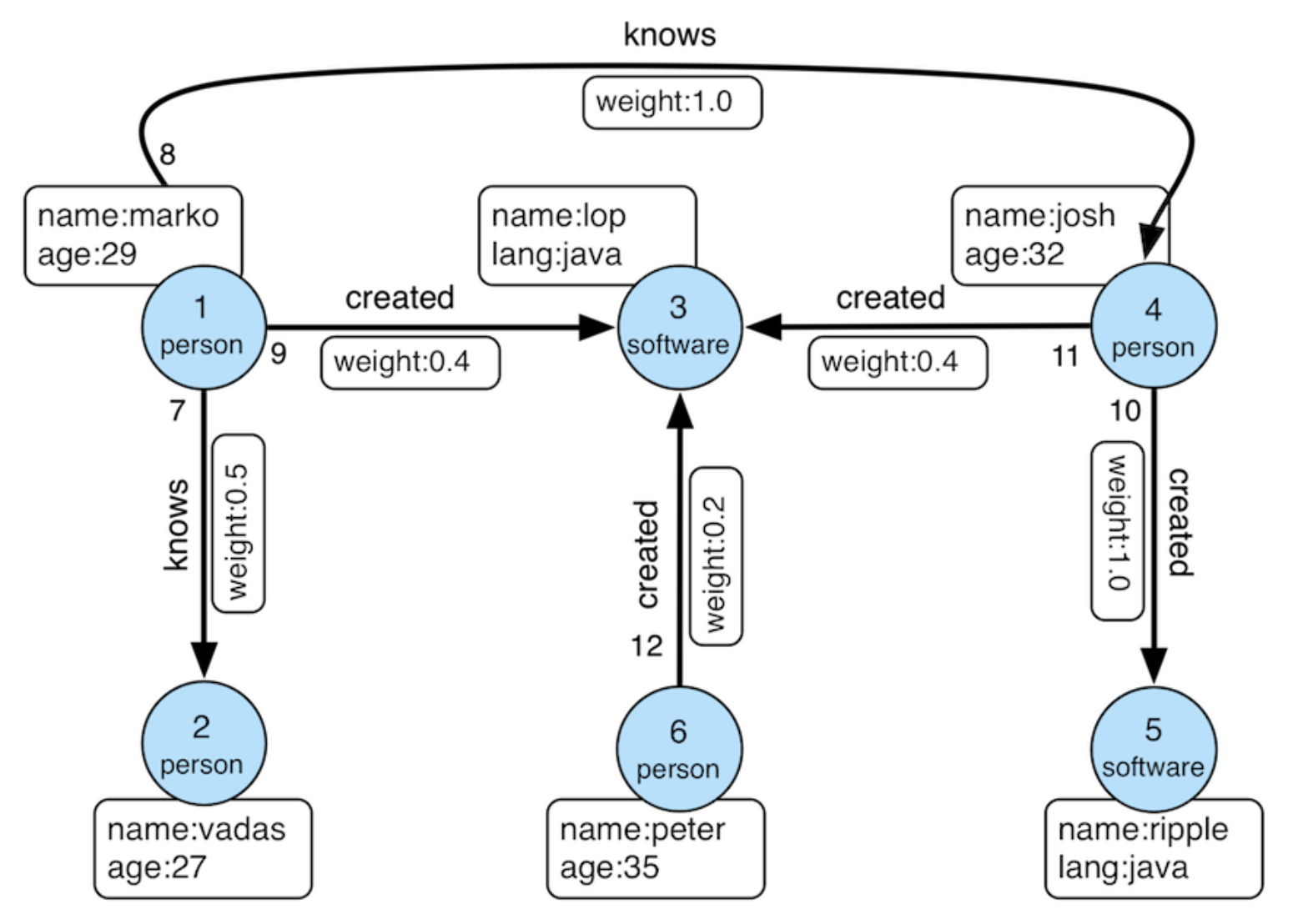
Modern Graph
A schema instructs PuppyGraph on mapping data from the Iceberg into a graph. PuppyGraph offers various methods for schema creation. For this tutorial, we've already prepared a schema to help save time.

schema.json with the following content. Please replace configuration parameters with the corresponding authentication information from your Databricks and AWS accounts.
schema.json
{
"catalogs": [
{
"name": "delta_test",
"type": "deltalake",
"metastore": {
"type": "unity",
"host": "[databricks_host]",
"token": "[databricks_token]",
"databricksCatalogName": "[databricks_catalog]"
}
}
],
"graph": {
"vertices": [
{
"label": "person",
"oneToOne": {
"tableSource": {
"catalog": "delta_test",
"schema": "modern",
"table": "person"
},
"id": {
"fields": [
{
"type": "String",
"field": "id",
"alias": "id"
}
]
},
"attributes": [
{
"type": "Int",
"field": "age",
"alias": "age"
},
{
"type": "String",
"field": "name",
"alias": "name"
}
]
}
},
{
"label": "software",
"oneToOne": {
"tableSource": {
"catalog": "delta_test",
"schema": "modern",
"table": "software"
},
"id": {
"fields": [
{
"type": "String",
"field": "id",
"alias": "id"
}
]
},
"attributes": [
{
"type": "String",
"field": "lang",
"alias": "lang"
},
{
"type": "String",
"field": "name",
"alias": "name"
}
]
}
}
],
"edges": [
{
"label": "knows",
"fromVertex": "person",
"toVertex": "person",
"tableSource": {
"catalog": "delta_test",
"schema": "modern",
"table": "knows"
},
"id": {
"fields": [
{
"type": "String",
"field": "id",
"alias": "id"
}
]
},
"fromId": {
"fields": [
{
"type": "String",
"field": "from_id",
"alias": "from_id"
}
]
},
"toId": {
"fields": [
{
"type": "String",
"field": "to_id",
"alias": "to_id"
}
]
},
"attributes": [
{
"type": "Double",
"field": "weight",
"alias": "weight"
}
]
},
{
"label": "created",
"fromVertex": "person",
"toVertex": "software",
"tableSource": {
"catalog": "delta_test",
"schema": "modern",
"table": "created"
},
"id": {
"fields": [
{
"type": "String",
"field": "id",
"alias": "id"
}
]
},
"fromId": {
"fields": [
{
"type": "String",
"field": "from_id",
"alias": "from_id"
}
]
},
"toId": {
"fields": [
{
"type": "String",
"field": "to_id",
"alias": "to_id"
}
]
},
"attributes": [
{
"type": "Double",
"field": "weight",
"alias": "weight"
}
]
}
]
}
}

puppygraph and password puppygraph123.

PuppyGraph Login

schema.json in the Upload Graph Schema JSON block and clicking on Upload.
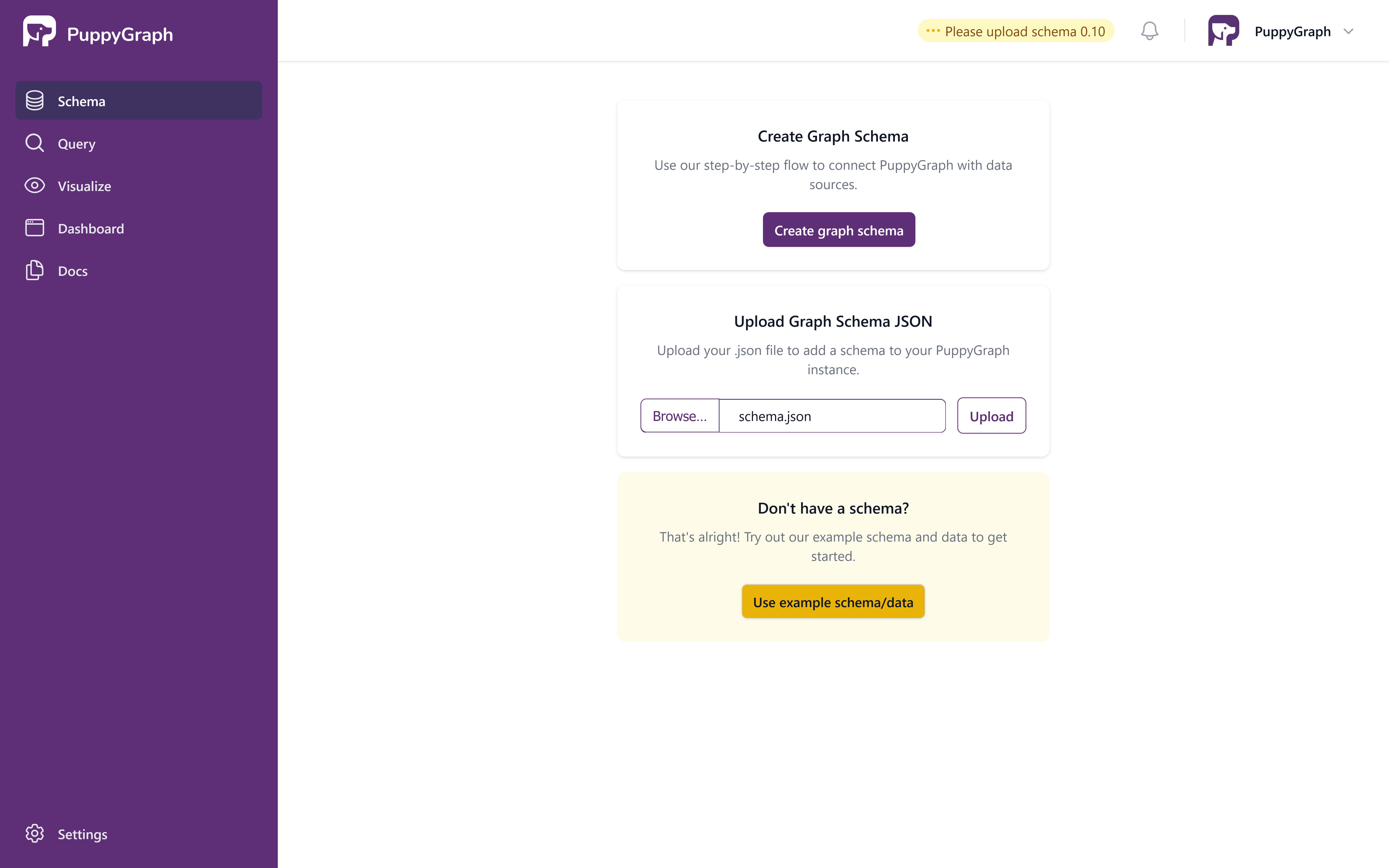
Upload Schema Page
Once the schema is uploaded, the schema page shows the visualized graph schema as follows.
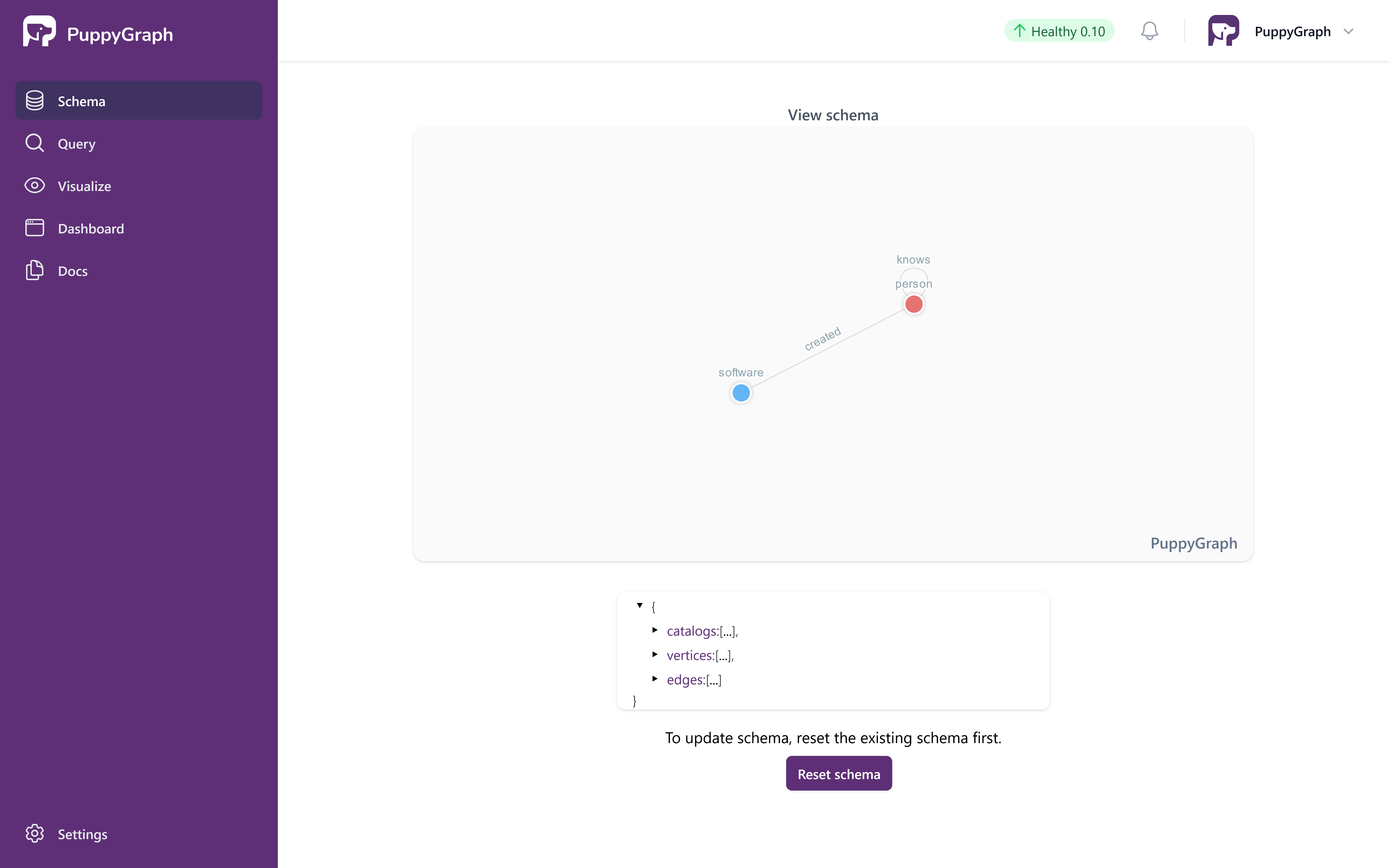
Visualized Schema
Alternative: Schema Uploading via CLI

curl -XPOST -H "content-type: application/json" --data-binary @./schema.json --user "puppygraph:puppygraph123" localhost:8081/schema
The response shows that graph schema has been uploaded successfully:
Querying the Graph
In this tutorial we will use the Gremlin query language to query the Graph. Gremlin is a graph query language developed by Apache TinkerPop. Prior knowledge of Gremlin is not necessary to follow the tutorial. To learn more about it, visit https://tinkerpop.apache.org/gremlin.html.

Query panel the left side. The Gremlin Query tab offers an interactive environment for querying the graph using Gremlin.
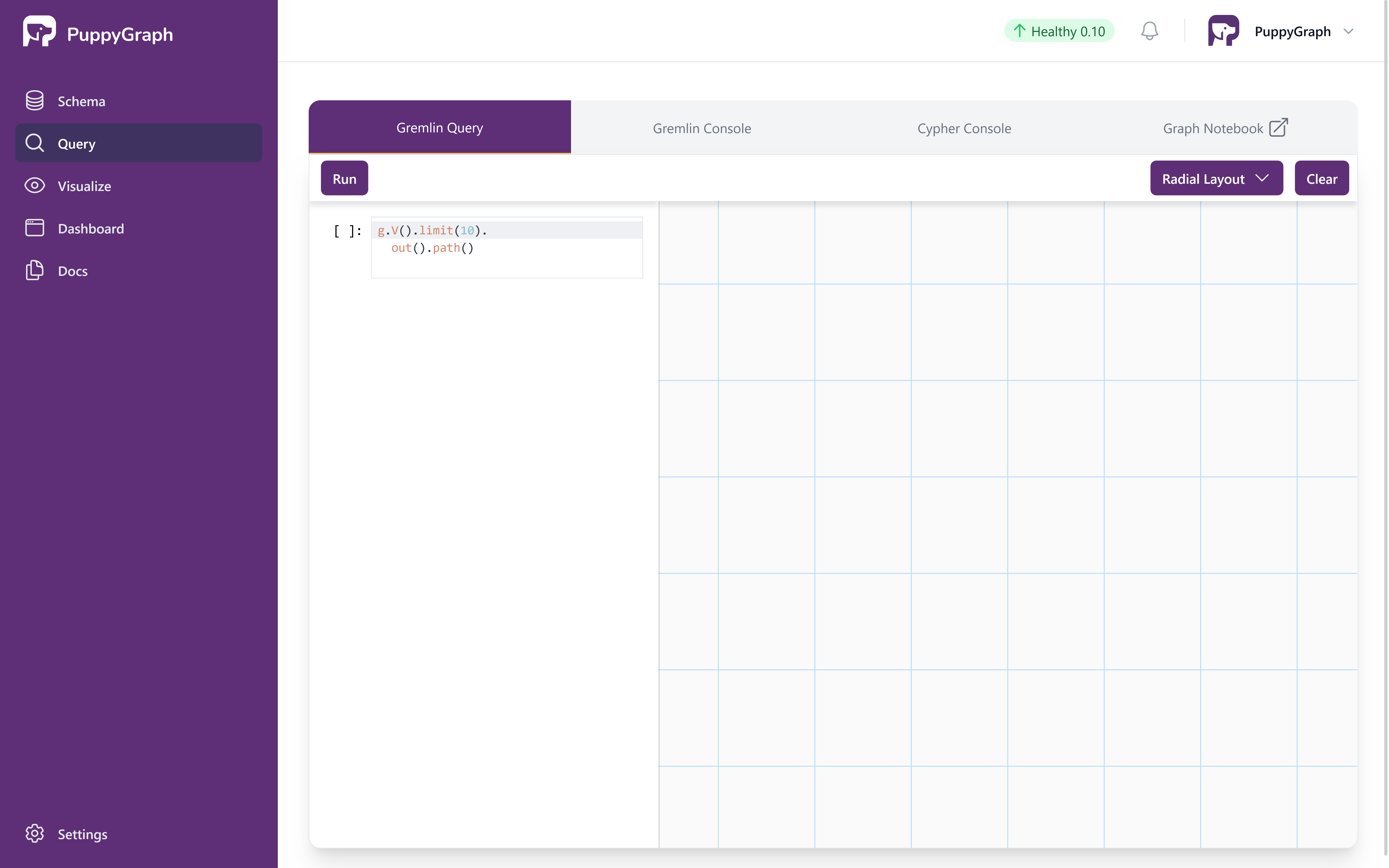
Interactive Gremlin Query Page
Queries are entered on the left side, and the right side displays the graph visualization.
The first query retrieves the property of the person named "marko".

The output is plain text like the following:
Now let's also leverage the visualization. The next query gets all the software created by people known to "marko".

The output is as follows. There are two paths in the result as "marko" knows "josh" who created "lop" and "ripple".

Interactive Query with Results
Alternative: Querying the graph via CLI
Alternatively, we can query the graph via CLI.

The welcome screen appears as follows:
____ ____ _
| _ \ _ _ _ __ _ __ _ _ / ___| _ __ __ _ _ __ | |__
| |_) | | | | | | '_ \ | '_ \ | | | | | | _ | '__| / _` | | '_ \ | '_ \
| __/ | |_| | | |_) | | |_) | | |_| | | |_| | | | | (_| | | |_) | | | | |
|_| \__,_| | .__/ | .__/ \__, | \____| |_| \__,_| | .__/ |_| |_|
|_| |_| |___/ |_|
Welcome to PuppyGraph!
version: 0.10
puppy-gremlin>

Properties of the person named "marko":

Cleaning up

You can then remove the tables created in your Databricks workspace.